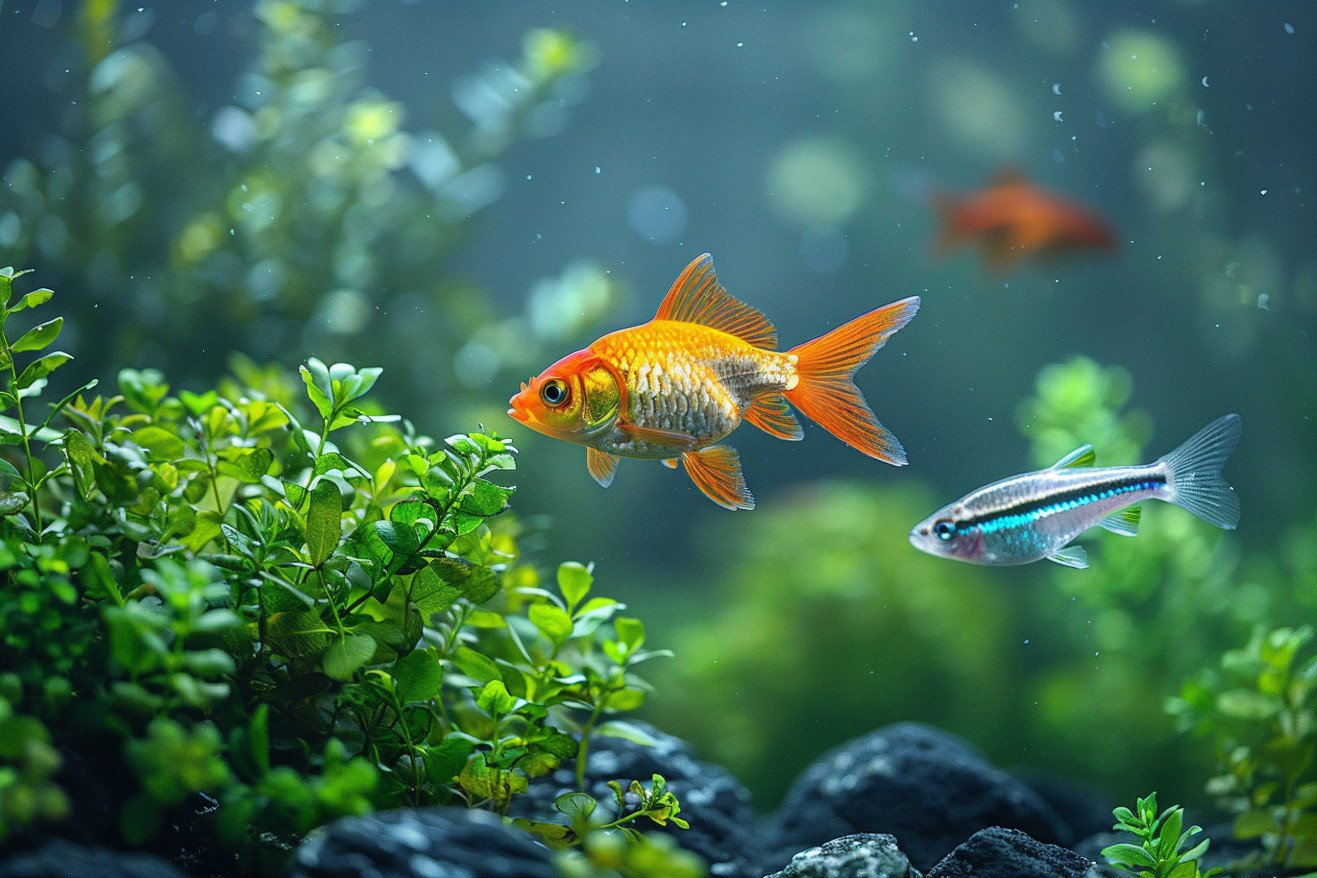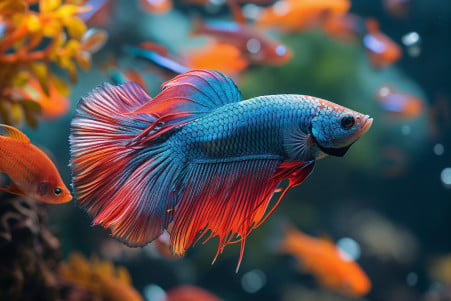Best Tank Mates for Goldfish: How to Build a Happy Aquarium
16 March 2024 • Updated 15 March 2024

Building a peaceful aquarium community begins with understanding which other fish can live with goldfish. Some of the best tank mates for goldfish are Zebra Danios, White Cloud Mountain Minnows, Rosy Barbs, and Bristlenose Plecos. Look for non-aggressive fish that are about the same size as goldfish and can live in the same temperature range (65–75 degrees Fahrenheit) and water conditions to ensure that your fish will get along.
To help you build a successful aquarium, we’ll look at a wide range of aquaculture research, including studies of natural ecosystems and expert advice from experienced fishkeepers. We’ll pay special attention to species compatibility, water parameter needs, and behavioral considerations that will help you make sure that your goldfish can live peacefully with other fish.
By doing this, we hope to give you the tools you need to meet the environmental and social needs of a shared aquatic environment and build a happy, healthy underwater community.
What fish can live with goldfish?
Setting Up the Perfect Tank: Water Quality for Goldfish
Goldfish require a specific water temperature range and other water quality factors that will enable them to live and grow comfortably. The ideal water temperature for goldfish is between 68°F and 74°F (20°C – 23°C), according to Practical Fishkeeping. Higher temperatures will help goldfish grow faster and reduce stress, while lower temperatures are necessary for rest and breeding.
The stability of pH levels is also important; goldfish can tolerate a pH range of 6.0 to 8.0, but sudden changes can cause stress. It’s better to have a stable pH, even if it’s not in the ideal range, than to have a pH that fluctuates frequently, which can be harmful, according to Pets on Mom.
In addition, goldfish need to be in a well-oxygenated environment, and the warmer the water, the less oxygen it can hold. This means that it’s especially important to make sure that the water is well-oxygenated if you’re keeping goldfish in a warmer environment. This is important for the health and well-being of the goldfish and any other fish that you may want to keep in the tank with them.
Tank owners should be prepared to monitor the temperature and pH of the water and make sure that the tank is well-equipped with aeration to ensure that the water quality is conducive to the health and well-being of the goldfish and any other fish that they want to keep in the tank.
This is especially important if you want to keep a mixed-species tank, as it will help ensure that all of the fish in the tank are able to live together comfortably.
How to Use This Information to Keep a Happy Goldfish Tank
Goldfish are naturally social creatures, and their social behaviors are a reflection of their environment and the other fish they live with. The Goldfish Tank explains that goldfish can even recognize and react to other fish and the people who take care of them. This level of social interaction means that it is important to make sure that you are choosing the right fish to live with your goldfish.
Goldfish are typically foraging and chasing other fish. Foraging is a sign of a healthy, happy fish that is exploring its environment, while chasing can be a sign of stress or mating, according to the Animal Welfare Institute. Understanding these behaviors is important so that you can tell the difference between a happy goldfish and one that is stressed and competing for resources or ready to mate.
Goldfish don’t seem to have a preference for any particular level in their tank and will often explore all of the levels of their tank. That said, if you notice that your goldfish are spending a lot of time at the top of the tank, it can be a sign that the water quality is poor or that the oxygen levels are low, which can be stressful.
This means that it is important to make sure that you are keeping the water clean and well-aerated to prevent stress.
By observing your goldfish and ensuring that their environment is stable, you can help manage their behavior and ensure that they are coexisting peacefully with the other fish in their tank.
When you are adding new fish to the tank, make sure to think about how they will fit into the existing social structure and whether they will be compatible with your goldfish’s lifestyle and use of space so that you can create a tank where all of the fish are happy and healthy.
Best Tank Mates for Your Goldfish Tank
To create a successful community tank with goldfish, you need to choose tank mates that are compatible with goldfish in terms of temperament and water requirements. FishLab explains that Zebra Danios are fast swimmers that can get away from goldfish, so they make good tank mates. The White Cloud Mountain Minnow is also recommended by experts as it can live in cooler water similar to what goldfish need.
Tank size and temperament are important factors in this equation. For example, Advanced Aquarium Concepts and Aquarium Source explain that the Bristlenose Pleco is a non-aggressive algae eater that won’t harass goldfish. Meanwhile, Rosy Barbs are great because they are active, colorful, and peaceful shoaling fish that won’t cause any problems.
When adding these fish to your tank, it’s important to make sure that they are acclimated to the tank’s temperature, which will likely be between 65°F and 75°F.
In addition, make sure that the fish you add are similar in size to your goldfish to avoid any accidental predation and to make sure that the tank is a peaceful place for all of its inhabitants. If you choose your tank mates based on these factors, not only will your goldfish tank be a peaceful place, but it will also be a beautiful one.
Maintaining a Mixed Tank: What Goldfish Eat
Goldfish are natural bottom feeders and omnivores, and they eat almost constantly. INJAF notes that goldfish are scavengers that sift through the substrate and plants in their environment to find food, which can include everything from plant matter to small invertebrates. This constant scavenging means that the other fish in the tank should have similar dietary needs to avoid food competition.
The Spruce Pets recommends that goldfish food should be made up of a mix of protein, fat, and fiber and have a protein level of about 30% for adult fish. Therefore, other fish in the tank should have similar dietary needs. For example, White Cloud Mountain Minnows and Zebra Danios also eat a varied diet that includes both plant and animal matter.
It’s also important to make sure that the fish in the tank are on a similar feeding schedule. Feeding schedules and portion control are important in a shared tank.
Complete Goldfish Care suggests feeding goldfish several small meals a day that they can eat in a few minutes. This is important because overfeeding can lead to too much waste in the tank, which can lead to toxicity in the water. This can be dangerous for the fish in the tank.
By making sure that all of the fish in the tank are on a similar feeding schedule, you can make sure that they are all eating a balanced diet.
In addition, it’s important to make sure that the fish in the tank are on a similar feeding schedule. Overfeeding can lead to too much waste in the tank, which can lead to toxicity in the water. This can be dangerous for the fish in the tank.
Keeping Things Clear: Filtration in a Goldfish Community Tank
Filtration is one of the most important factors in keeping water quality high and is the foundation of a healthy aquarium. Fish waste, decaying organic matter, and uneaten food all produce toxins, such as ammonia and nitrates, that can be harmful to fish. A good filtration system can help remove these toxins, which can help reduce the frequency of water changes, according to Natural Environment Aquatix.
The three main types of filtration are mechanical, biological, and chemical. Mechanical filters, like sponge filters, work to physically remove waste and debris from the water. Biological filtration uses beneficial bacteria to break down and convert harmful ammonia into less harmful nitrites and nitrates, according to Aquarium Adventure Columbus. Chemical filtration uses activated carbon or resins to remove impurities and odors from the water.
When choosing a filtration system for a community tank that includes goldfish, it’s important to take into account the bioload and the needs of the fish. It’s best to choose a filter that’s rated for the size of the tank and the number of fish in it, according to PetMD.
It’s also important to keep the filtration system clean in order to maintain a healthy tank. This means regularly cleaning the filter and replacing the filter media. To maintain a biological filter, rinse the filter media in aquarium water, and replace the chemical media when it’s no longer effective. With a clean filter, your goldfish and other fish will be able to live in a healthy, clear environment.
Building a Successful Goldfish Community: A Summary
Throughout our deep dive into the world of goldfish companionship, it has become evident that the best tank mates for goldfish are a delicate balance of water parameters, social behavior, dietary needs, and filtration. A successful community will improve the goldfish’s life by creating a peaceful environment. We have found species like Zebra Danios and White Cloud Mountain Minnows that match the goldfish’s peaceful nature and water requirements, making them ideal tank mates.
Good pet parents don’t stop caring for their fish after they set up the tank. Instead, they continue to learn and watch to make sure they are providing the best care for each of their aquatic friends. Pet parents are dedicated to learning about and accommodating the goldfish and their tank mates’ unique needs and behaviors.
In the end, the joy of watching a diverse community thrive and grow is the ultimate reward for those who take the time to care for their aquarium responsibly and thoughtfully. By following these guidelines, aquarium hobbyists can build a beautiful underwater world that is full of color and life.


